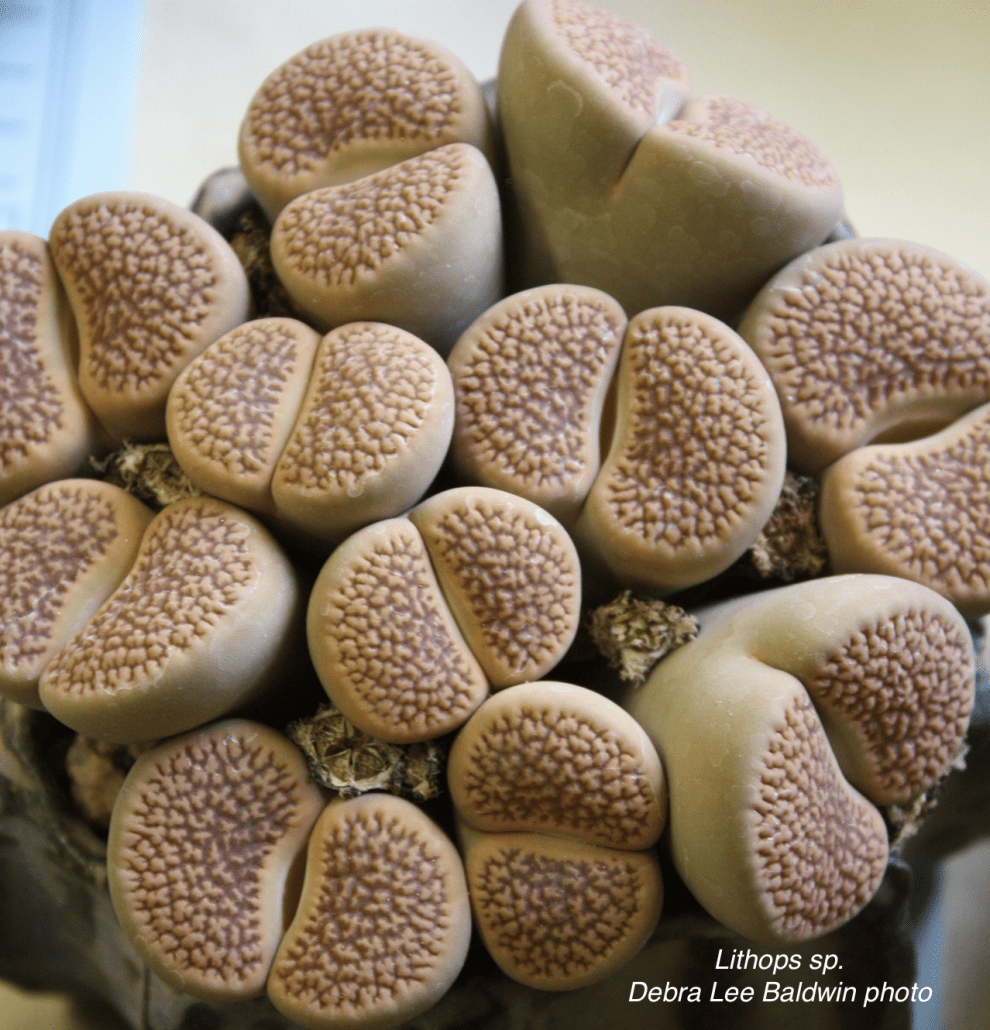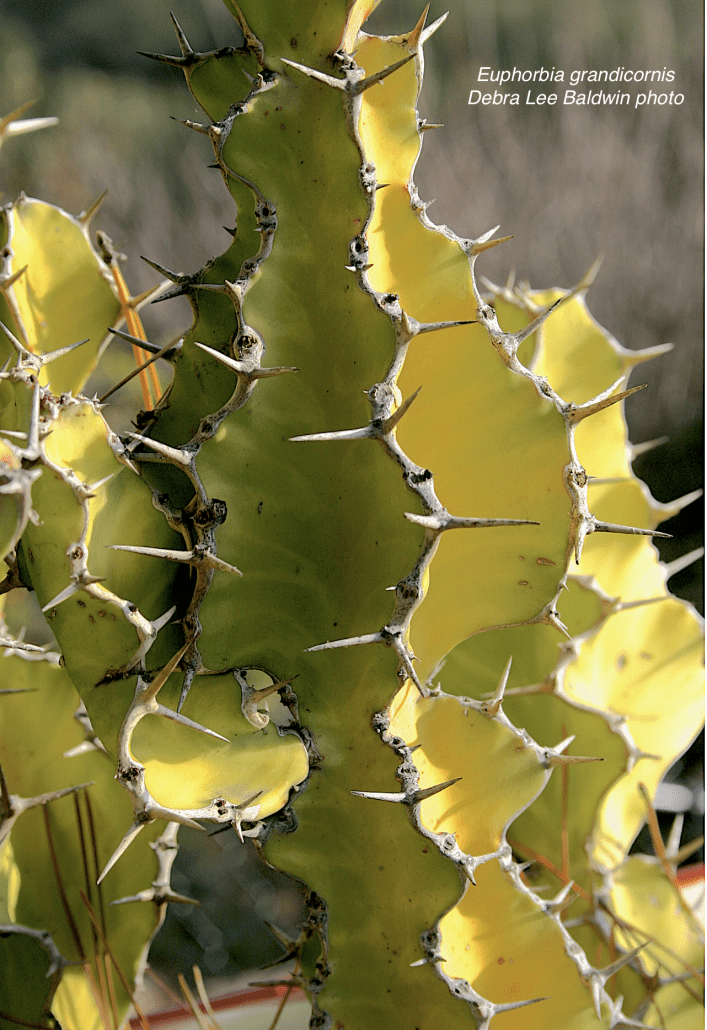Bizarre Succulents for Your Collection, Bwa-ha-ha
Bizarre succulents are in the eye of the beholder. You might go to a Cactus & Succulent Society show and hear members exclaim how “beautiful” a lumpy plant is and wonder if their eyes need checking. Personally what I find bizarre are succulents that suggest something they’re not in an eerie way—i.e. a cancerous growth, reptile or body part. When I take a second look and ponder what the heck it is, I have a deliciously unsettling ah-ha (or bwa-ha-ha) moment.
Btw, the bizarre succulents shown here inspired one of my few forays into fiction: Professor Mordant’s Sea-Sand Succulents. Do enjoy moonlit photos and a “pleasantly unsettling” reinterpretation of collectible-yet-creepy succulents. Excerpt: I alone accepted the professor’s invitation. I calmed my trepidation by anticipating a big story…or at least a small adventure. It turned out to be both. But except for these photos, I’m unable to prove it. I fear that now, after the tsunami, this is the only record that remains…[Continue reading]
Debra’s Gallery of Bizarre Succulents

Mammillaria elongata, crested
This is the crested, or monstrose, form of a fairly ordinary cactus that consists of fuzzy cylinders, commonly called “ladyfingers” (after the golden pastry often served with afternoon tea). When ladyfingers turn monstrose, they enter an entirely different world…that of horror movies. Anyone need a spare brain?

Lithops sp.
Lithops, or living stones, is always plural (no such thing as a “lithop,” please). These grow glacially and can be difficult to keep alive because their tap roots are prone to rot if overwatered. In their native habitat of South Africa, lithops go without rain for months, sometimes years. To avoid being eaten by thirsty animals, they’re buried in sand to their tops, which have translucent fissures that enable sunlight to enter the plant.

Crassula ‘Baby’s Necklace’
These remind me of eels emerging from an undersea crevice. They look as though they’re swaying in a current, hoping to catch passing plankton or tiny fish. This is one of the “stacked crassulas” which are a subsection of a genus best known for jade plants. What makes them similar are the flowers, which to botanists are THE defining characteristic of a genus.

Gasteria hybrid
I don’t know much about this succulent, which I shot at a nursery, other than it’s a gasteria. The color and texture alone makes it bizarre, but its shape takes it over the top. Doesn’t it look like it’s crawling toward you?

Medusa euphorbia in flower.
Medusa euphorbias are bizarre even when not in bloom. Their stems radiate from a central point in a Fibonacci spiral, forming what looks like scaly snakes. From Wikipedia: “In Greek mythology, Medusa was a monster, a Gorgon, generally described as a winged human female with living venomous snakes in place of hair. Those who gazed upon her face would turn to stone.”

Euphorbia grandicornis
This is a euphorbia that sure looks like a cactus, but its thorns don’t radiate from central points (aureoles), and the flesh has a milky sap. The Latin means “large horn;” the common name is “cow’s horn.” Plants can form thickets 6 feet tall.

Tillandsia sp.
Air plants (Tillandsia species) are not succulents, but often are paired with them. They have a wonderful tentacled look, and some suggest spiders or sea urchins.

Echeveria ‘Mauna Loa’
This is one of many carruncled echeverias hybridized by Dick Wright. The lava-flow leaves doubtless inspired him to name it after a volcano. Such bumpy echeverias polarize collectors, who tend to love or hate them. I think they’re cool in a weird way, and I like how each cancerous-like mass is slightly different. Definitely a plant that makes you look twice!

Pilosocereus sp.
I turned this photo sideways in my fictional story about sea-sand succulents, so the flowers would appear to grow upright. This cactus is truly blue, and its blooms—especially when they turn black—are truly bizarre.

Fenestraria aurantiaca ‘Baby Toes’
I bought my first Baby Toes at the county fair when I was around 20, put it on the kitchen counter and overwatered it, thereby causing it to rot and die. During the decades since then, I’ve come to realize it wants a few hours of sun daily (lest it elongate), and can tolerate more water than most plants in the “living stones” category (like lithops). The name comes from the Latin for “window.”

Euphorbia obesa
When the succulent craze took off, these little fatties became so popular that they became scarce. This is typical of highly desirable succulents that are extremely slow growing. I hope sometime soon we’ll see marvelous colonies of obesas again, like this one I shot back in ’07.

Myrtillocactus geometrizans, crested
This is a plant I associate with Jeff Moore of Solana Succulents nursery and the undersea garden he designed at the San Diego Botanic Garden. Jeff, a lifelong resident of Solana Beach, CA, is fond of snorkeling. As a nurseryman specializing in succulents, plants like these reminded him of what he saw underwater, and voila: a trend was born.

Boweia volubis (pregnant onion)
Here’s another succulent that polarizes collectors: Do you love pregnant onions or hate them? The bulbs, which sit atop the soil, have peeling skin and a hole at the top from which this green frizz emerges. It twines around whatever it can find, then dies back. I think they’re interesting, but not especially beautiful.

Astrophytum ornatum, crested
By now you may have noticed that many of these bizarre plants are crested. As I explain on page 199 of Designing with Succulents (2nd ed.), “cresting happens when new growth emerges from a line rather than a point…Odd lumpy forms, sometimes but not always caused by cresting, are monstrose.” I love the fang-like spines on this crested astrophytum (so named because it’s star-shaped).

Aloe vanbalenii (Van Balen’s aloe)
Aloe vanbalenii is a fairly common landscape succulent, but seldom seen this red and compact. As with most succulents that stress to colors of red and orange, this one has tightened up, forming what looks like a multiheaded squid. That color!
Related Info on This Site:
The post Bizarre Succulents appeared first on Succulents and Succulent Garden Design | Debra Lee Baldwin.
from Succulents and Succulent Garden Design | Debra Lee Baldwin https://ift.tt/2PIiUtK
via IFTTT


No hay comentarios:
Publicar un comentario